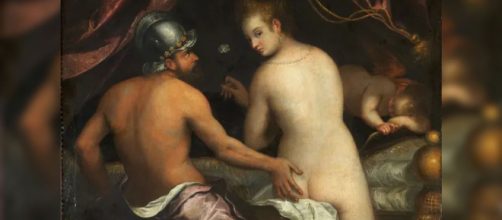There was a time when nudes in art were the highest expression of human aspiration, the very embodiments of ideals like faith and courage. The statue of “David” makes that case.
But when it came to female nudes, the art world made them into objects, the consummate still life, intellectually undemanding. Old Master paintings of a reclining Venus by Giorgione, Titian, and Velázquez are like that – eye candy.
Behind the scenes
Such limited views of Venus make the 16th-century painter Lavinia Fontana remarkable. Consider her picture “Mars and Venus,” on view in a one-person show at the National Gallery in Ireland starting May 6.
What you see is the mythological couple in a private moment with Mars fondling Venus’s exposed backside. Certainly not a view of the goddess that artists typically paint.
Ireland’s exhibit title – “Lavinia Fontana: Trailblazer, Rule Breaker” – makes her out to be an upstart. Granted, she was the first female artist in history to paint a nude woman. But should rebellion be her claim to fame?
I question whether this artist, a mother of 11 and official portraitist of Pope Gregory XIII, set out to violate societal norms. I think she simply wanted to change the way male artists viewed Venus, and she had to show her in the altogether to make her case.
By getting the goddess out of the archetypal reclining pose, and into an interactive scene, Fontana looks to be correcting the picture-making record as written by the ancient Romans.
Venus, the fantasy
And according to that record, Venus was a terrible example of a love goddess, unless you count nymphomania as loving. While married to Vulcan, she had numerous affairs, not only with gods like Mars, but also with mortals such as Adonis.
The National Gallery lauds Fontana for being the first woman to paint nudes.
But shouldn’t the emphasis be on her portraying Venus’ true story rather than regurgitating the same romanticized version seen throughout art history?
When you see the goddess looking over her shoulder directly at us, it’s as if the artist were asking why we sentimentalize Venus and edify her as a goddess of love.
Why, for example, does Botticelli‘s “The Birth of Venus” make the goddess out to be a newborn – innocent and shy?
By her lifestyle, Venus was no shrinking violet, and I think Fontana was making that point.
Maybe she was even moralizing, chastising us for forgetting that Cupid, another of our beloved icons of love, was Venus’ illicit son with Mars.
All of this is to say I don’t think that in “Mars and Venus” Fontana is making nudity the issue. I think she is making Venus the issue. Likely Fontana read Virgil’s Aeneid and wondered, as I do, why he viewed her as a heavenly figure, glowing even in the sky at daylight.
One more thing. Fontana was not known as a figure painter. She painted portraits for a living. Yet, she took on Venus to portray her character. And by nailing that, she showed her portrait painting bona fides.


